Sometimes I envy those people on the Georgia barrier islands who, through sheer number of hours in the field, come upon animal traces that I’ve never seen there. But this was one of those instances where the find was so extraordinary that I will suppress my jealous urges, celebrate the person who found it, marvel at it, and share its specialness with others.
Gale Bishop, a fellow ichnologist who is currently on St. Catherines Island, found an intriguing sequence of traces during a morning foray on its dunes and beaches there last week. In his second life – his first was as a geology professor at Georgia Southern University – he has transformed into an indefatigable sea-turtle-nesting monitor on St. Catherines and coordinator of a teacher-training program. Part of his daily routine there, among many other duties, includes looking for mother-turtle traces – trackways and nests – during the nesting season, which in Georgia is from May through September.
Along the way, with his eyes well trained for spotting jots and tittles in the sand, Gale often notices oddities that likely would be missed by most people, including me. The following photograph, which he shared on the St. Catherines Island Sea Turtle Program page on Facebook, is from a find he made about 7:15 a.m. on Saturday, July 7. Take a look, and please, if you haven’t already, forget the title of this post as you ponder its clues.
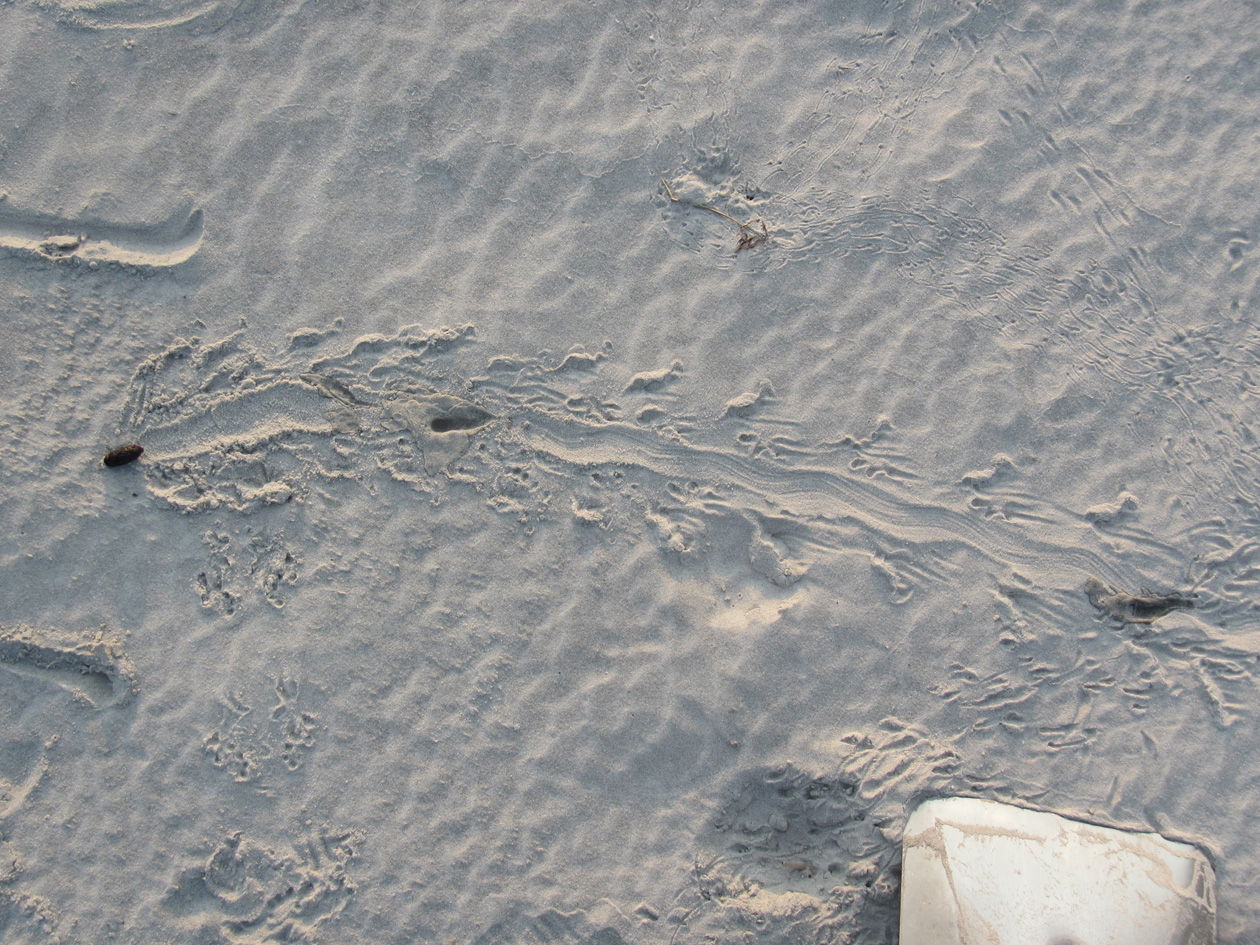 A mystery in the dune sands of St. Catherines Island on the Georgia coast, begging to be interpreted. No, not the shovel: those are never mysterious. Look at the traces to the left and above the shovel. What made these, what was it doing, and who else was in the neighborhood afterwards? Oh, and again, stop staring at the shovel. (Photograph by Gale Bishop.)
A mystery in the dune sands of St. Catherines Island on the Georgia coast, begging to be interpreted. No, not the shovel: those are never mysterious. Look at the traces to the left and above the shovel. What made these, what was it doing, and who else was in the neighborhood afterwards? Oh, and again, stop staring at the shovel. (Photograph by Gale Bishop.)
Gale called me out specifically when he posted this and several other related photos on Facebook, and asked me to tell a story about it. I gave him my abbreviated take in the comments, kind of like an abstract for the research article:
Looks like southern toad (Bufo terrestris) to me. What’s cool is the changes of behavior: hopping, stopping, pooping, and alternate walking (which people don’t expect toads to do – but they do).
That was my knee-jerk analysis, which took a grand total of about a minute to discern and respond. (After all, this was Facebook, a forum in which prolonged and deep thinking is strongly discouraged.) But I also kept in mind that quick, intuitive interpretations later need introspection and self-skepticism, especially when I’m making them. (See my previous post for an example of how wrong I could be about some Georgia-coast traces.) So rather than fulfill some Malcolm Gladwell-inspired cliché through my intuition, I sat down to study the photo with this series of questions in mind:
- Why did I say “Southern toad” as the tracemaker for the sequence of traces that start from the lower left and extend across the photo?
- What indicates the behaviors listed and in that order: hopping, stopping, pooping, and alternate walking?
- What signified the changes in behavior, and where did these decisions happen?
- Why did I assume that most people don’t expect toads to walk (implying that they think they just hop)?
The first leap in logic – how did I know a Southern toad (Bufo (Anaxyrus) terrestris) was the tracemaker – was the easiest to make, as I’ve often seen their tracks in sandy patches of maritime forests and coastal dunes. These hardy amphibians leave a distinctive bounding pattern, with the front-foot impressions together and just preceding the rear-foot ones; the toes of their front feet also point inward. In the best-expressed tracks, you will see four toes on the front feet and five toes on the rear.
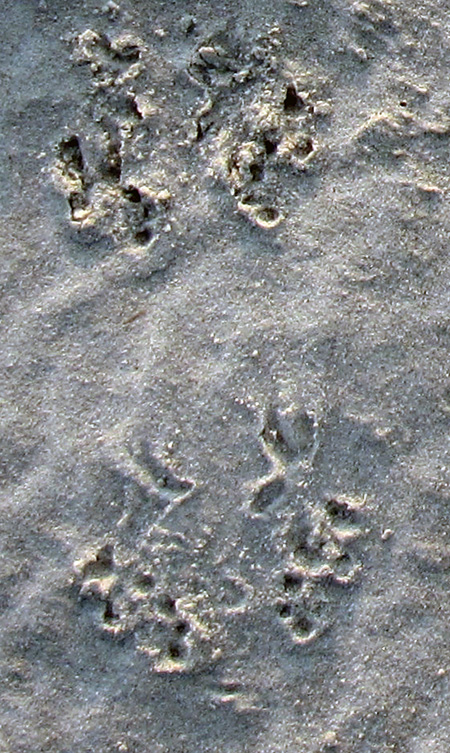 Close-up of bounding pattern (from lower left of previous photo), showing front-foot impressions just in front of and more central than the rear feet impressions. Direction of movement is from bottom to top of photo. (Photograph enhanced to bring out details, but originally taken by Gale Bishop.)
Close-up of bounding pattern (from lower left of previous photo), showing front-foot impressions just in front of and more central than the rear feet impressions. Direction of movement is from bottom to top of photo. (Photograph enhanced to bring out details, but originally taken by Gale Bishop.)
The only other possible animal that could make a trackway pattern confusable with a toad in this environment is a southeastern beach mouse (Peromyscus polionotus). Still, mice mostly gallop, in which their rear feet exceed their front feet as they move. Mouse feet are also very different from those of a toad, with toes on both feet all pointing forward (remember, toad toes point inward). So although dune mice live in the same environment as these tracks, these weren’t mouse tracks. The only alternative tracemakers would be spadefoot toads (Scaphiopus holbrookii) or a same-sized species of frog, such as the Southern leopard frog (Rana sphenocephala). But neither of these species is as common in coastal dunes as the Southern toad, so I’ll stick with my identification for now.
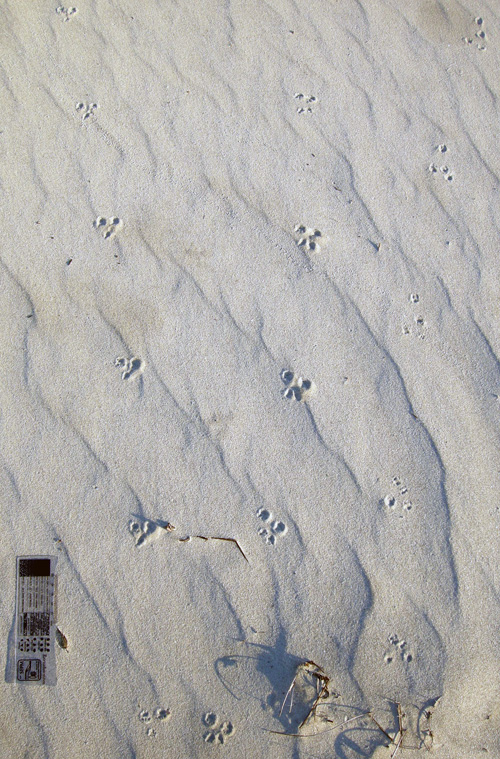 Mouse tracks – probably made by the Southeastern beach mouse (Peromyscus polionotus) – on costal dunes of Little St. Simons Island, Georgia. The two trackways on the left are moving away from you, whereas the one on the trackway on the right is heading toward you. All three show a gallop pattern, in which the larger rear feet exceeded the front feet. Scale = 10 cm (4 in). (Photograph by Anthony Martin)
Mouse tracks – probably made by the Southeastern beach mouse (Peromyscus polionotus) – on costal dunes of Little St. Simons Island, Georgia. The two trackways on the left are moving away from you, whereas the one on the trackway on the right is heading toward you. All three show a gallop pattern, in which the larger rear feet exceeded the front feet. Scale = 10 cm (4 in). (Photograph by Anthony Martin)
The second conclusion – the types of behaviors and their order – came from first figuring out the direction of travel by the tracemaker, which from the lower left of the photo toward its middle. This shows straight-forward hopping up to the point where it stops.
From there, it gets really interesting. The wide groove extends to the left past the line of travel and had to be made by the posterior-ventral part of the toad’s body (colloquially speaking, its butt). This, along with the disturbed sand on either side of the groove, shows that the toad turned to its right (clockwise) and backed up with shuffling movement. That’s when it deposited its scat, which I’ve also seen in connection with toad tracks (and on St. Catherines, no less). This really helped me to nail down the identity of the tracemaker, almost being able to declare, “Hey, I know that turd!”
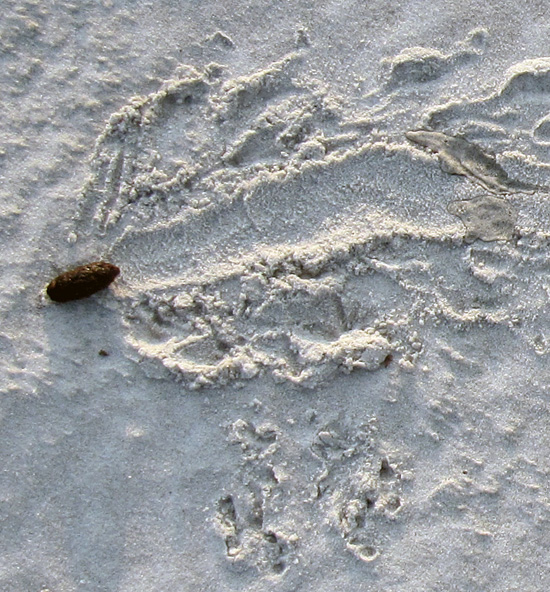 Southern toad bounding pattern that abruptly stops, followed by clockwise turning, backing up, and, well, making a deposit. (Photograph by Gale Bishop, taken on St. Catherines Island.)
Southern toad bounding pattern that abruptly stops, followed by clockwise turning, backing up, and, well, making a deposit. (Photograph by Gale Bishop, taken on St. Catherines Island.)
How about the alternate walking? Turns out that toads don’t just hop, but also walk: right side, left side, right side, and so on. This pattern – also called diagonal walking by trackers – is in the remainder of the photo (with the direction of movement left to right). When toads do this, the details of their front and rear feet are better defined, and you can more clearly see the front foot registers in front of the rear and more toward the center line of the body.
This side-by-side movement is also what imparted a slight sinuosity to the central body dragmark, which was from the lower (ventral) part of its body, or what some people would call “belly.” In my experience, most people are very surprised to find out that toads can walk like this, which I can only attribute to sample bias. In other words, they’ve only seen frogs and toads hop away from them when startled by the approach of large, upright bipeds.
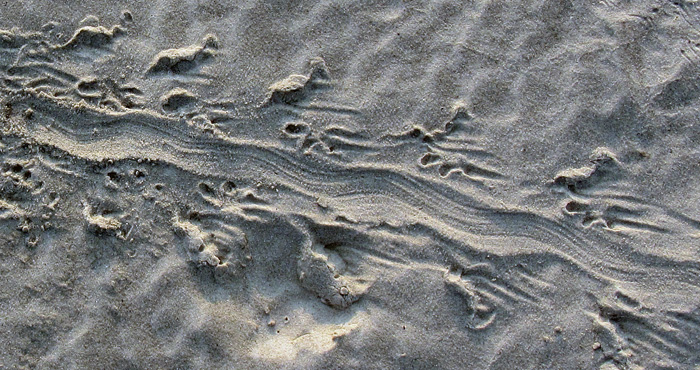 Close-up of alternate walking pattern and body dragmark made by Southern toad. Direction of movement is from upper left to lower right. (Photograph enhanced to bring out its details, but original taken by Gale Bishop on St. Catherines Island.)
Close-up of alternate walking pattern and body dragmark made by Southern toad. Direction of movement is from upper left to lower right. (Photograph enhanced to bring out its details, but original taken by Gale Bishop on St. Catherines Island.)
But wait, what are those two dark-colored depressions in the center of the alternate-walking trackway? Well, it doesn’t take much imagination to figure those out, especially if you’ve already had a couple of cups of coffee. Yes, these are urination marks, and even more remarkable, there are two of them in the same trackway. So not only did this toad do #2, but also #1 twice.
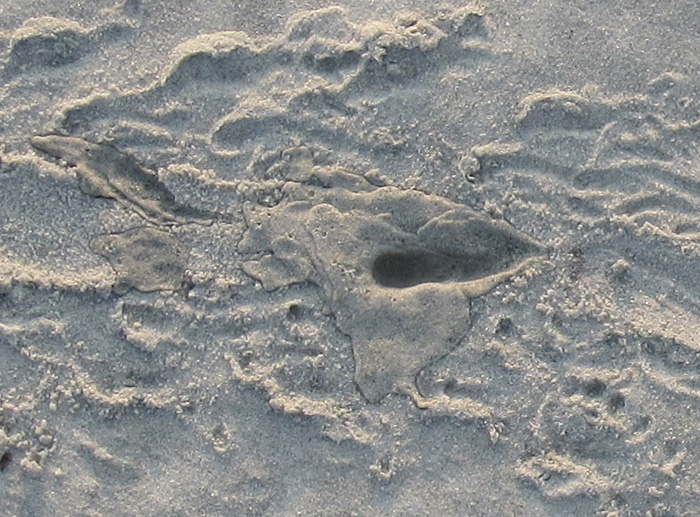 Southern toad urination mark #1, not too long after doing #2. (Photograph by Gale Bishop.)
Southern toad urination mark #1, not too long after doing #2. (Photograph by Gale Bishop.)
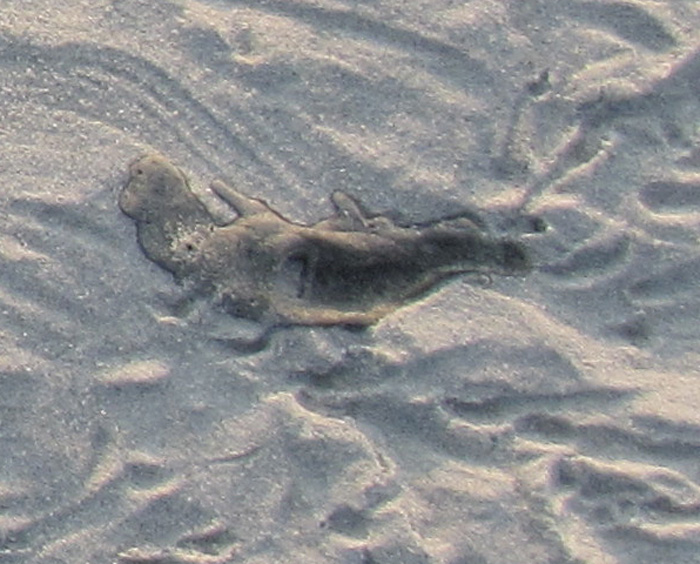 Urination mark #2 , which you might say was #2 of #1, but with both #1’s after #2, or, oh, never mind.
Urination mark #2 , which you might say was #2 of #1, but with both #1’s after #2, or, oh, never mind.
Notice that the second mark seems to have had less of a stream to it, which makes sense in a way that I hope doesn’t require any more explanation or demonstration.
So to answer to one of the questions above – what signified the changes in behavior – you have to look for the interruptions in the patterns, much like punctuation marks in a sentence. The commas, semi-colons, colons, dashes are all part of a story too, not just the words.
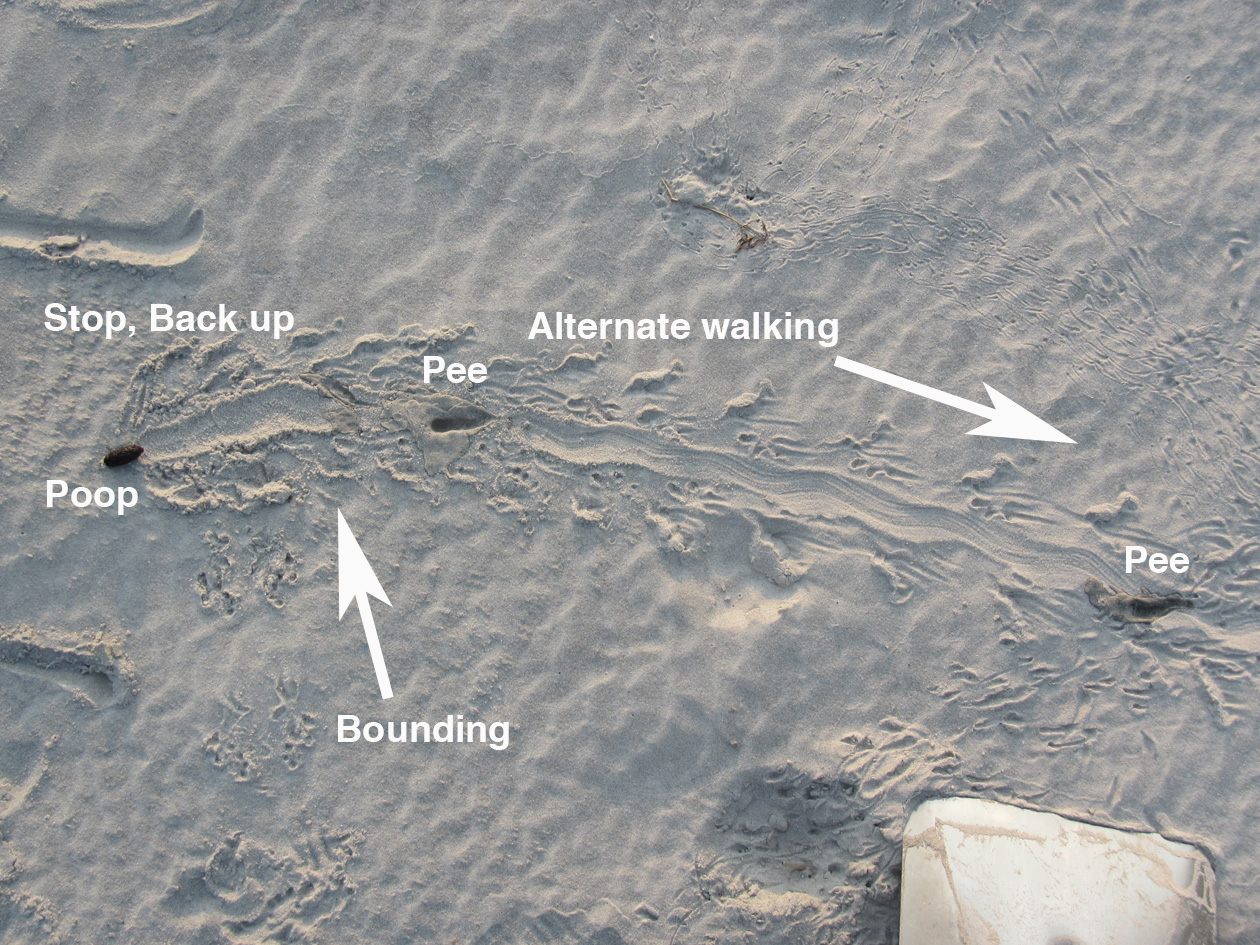 The summary interpretation of what happened. Let’s just say that this frog (or toad, whatever) didn’t come a courtin’.
The summary interpretation of what happened. Let’s just say that this frog (or toad, whatever) didn’t come a courtin’.
Through the series of photos Gale shared in an album on Facebook, he also showed that he was following a protocol all good trackers do: he changed his perspective while observing the traces. Likewise, I teach my students to use this same technique when presented with tracks and other traces, that it’s a good idea to walk around them. While doing this, they see changes in contrast and realize how the direction and angle of light on the traces alters their perceptions of it. At some points, a track or other trace may even “disappear,” then “reappear” with maximum clarity with just a few more steps.
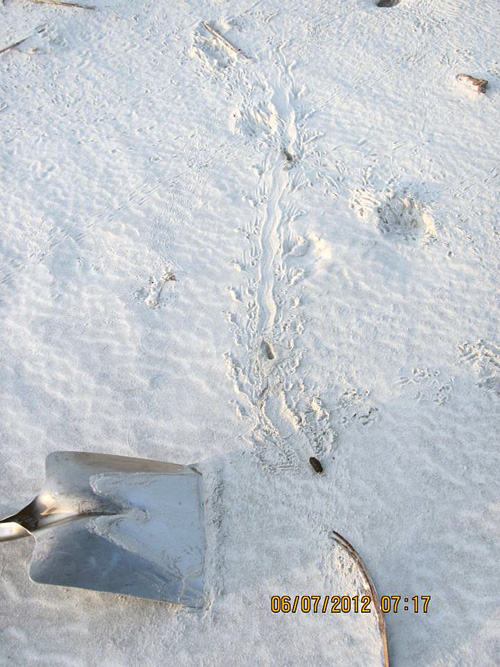 A different perspective of the same traces, viewed from another angle. Do you notice something new you didn’t see in the previous photo and its close-ups? (Photograph by Gale Bishop, taken on St. Catherines Island.)
A different perspective of the same traces, viewed from another angle. Do you notice something new you didn’t see in the previous photo and its close-ups? (Photograph by Gale Bishop, taken on St. Catherines Island.)
Now, because I’m also a paleontologist, this interesting series of traces also prompts me to ask: what if you found this sequence of traces in the fossil record? Well, it’d be a fantastic find, worthy of a cover story in Nature. (That is, if the tracks somehow went across the body of a feathered dinosaur.) Right now, I can’t think of any trace fossils like this coming from vertebrates – let alone toads or frogs – so let’s go to invertebrate trace fossils for a few examples of similarly interconnected behaviors preserved in stone.
In 2001, a sequence of trace fossils was reported from Pennsylvanian Period rocks (>300 million years old), in which a clam stopped, fed, and burrowed along a definite path, with all of its behaviors clearly represented and connected. The ichnologists who studied this series of trace fossils – Tony Ekdale and Richard Bromley – reckoned these behaviors all happened in less than 24 hours; hence the title of their paper reflected this conclusion.
Ichnologists have a sometimes-annoying and always-confusing practice of naming distinctive trace fossils, giving them ichnogenus and ichnospecies names. (For a detailed discussion of this naming method, I talked about it in another blog from the dim, dark, distant past of 2011 here.) For instance, Ekdale and Bromley stated in their study that three names could be applied to the distinctive trace fossils made by a single clam, with each a different form made by a different behavior: Protovirgularia (burrowing), Lockeia (stopping), and Lophoctenium (feeding).
Along those lines, another ichnologist (Andy Rindsberg) and I also suggested that an assemblage of trace fossils in Early Silurian rocks (>400 million years old) of Alabama, with many different ichnogenera, were all made by the same species of trilobite. The take-home message of that study, as well as Ekdale and Bromley’s, is that a single species or individual animal can make a large number of traces. This also means that ichnodiversity (variety of traces) almost never equals biodiversity (variety of tracemakers).
So let’s go back to the toad traces, put on our paleontologist hats, and think about a “what if.” What if you found this series of traces disconnected from one another: the hopping trackway pattern, the diagonal walking pattern, the urination marks, the groove, and the turd, all found in disparate pieces of rock? Taken separately, such trace fossils likely would be assigned different names, such as “Bufoichnus parallelis,” “B. alternata,” “Groovyichnus,” “Tinklichnus,” and “Poopichnus.” (Please do not use these names beyond an informal, jovial, and understandably alcohol-fueled setting.)

 Color, present-day version of the variety of traces made by a Southern toad (above), and a grayscale imagining of it fossilizing perfectly (below). Key for whimsically named ichnogenera in fossilized version: Bp = “Bufoichnus parallelis,” Ba = “Buofichnus alternata,” G = “Groovyichnus,” P = “Poopichnus,” and T = “Tinklichnus.” Please don’t cite this.
Color, present-day version of the variety of traces made by a Southern toad (above), and a grayscale imagining of it fossilizing perfectly (below). Key for whimsically named ichnogenera in fossilized version: Bp = “Bufoichnus parallelis,” Ba = “Buofichnus alternata,” G = “Groovyichnus,” P = “Poopichnus,” and T = “Tinklichnus.” Please don’t cite this.
Granted, the environment in which Gale noted these traces – coastal dune sands – are not all that good for preserving what is pictured here, but other environments might be conducive to fossilization. To quote comedian Judy Tenuta, “It could happen!”
So if someone does find a fossil analogue to Gale’s evocative find on St. Catherines Island, I will understand their giving a name to each separate part, even if I won’t like it. The most important matter, though, is not what you call it, but what it is. And in this case, the intriguing story of toiletry habits left in the sand one July morning by a Southern toad is worth much more than any number of names.
Further Reading
Ekdale, A.A., and Bromley, R.G. 2001. A day and a night in the life of a cleft-foot clam: Protovirgularia-Lockeia-Lophoctenium. Lethaia, 34: 119–124.
Halfpenny, J.C., and Bruchac, J. 2002. Scats and Tracks of the Southeast. Globe Pequot Press, Guilford, Connecticut: 149 p.
Jensen, J.B. 2008. Southern toad. In Jensen, J.B., Camp, C.D., Gibbons, W., and Elliott, M.J. (editors), Amphibians and Reptiles of Georgia. University of Georgia Press, Athens, Georgia: 44-46.
Rindsberg, A.K., and Martin, A.J. 2003. Arthrophycus and the problem of compound trace fossils. Palaeogeography, Palaeoclimatology, Palaeoecology, 192: 187-219.
